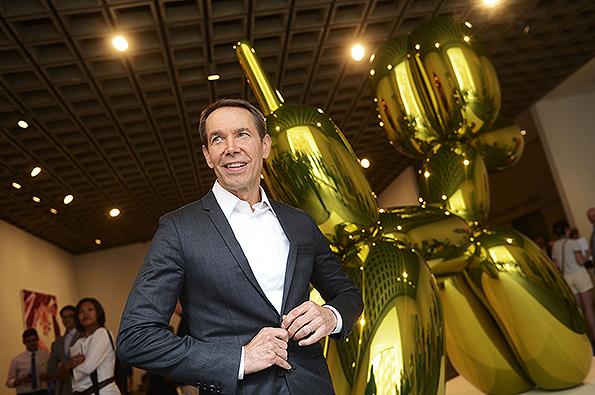
Jeff Koons, Poodle (1991).
Photo: Benjamin Sutton.
When sightings of Leonardo DiCaprio and Miley Cyrus (dressed as deranged vagabonds) at Art Basel in Miami cause a stir, one wonders what remains of the art world. Indeed it is tempting to think that the art world has been swallowed by the combined marketing and publicity machines of Hollywood and the fashion and music industries. Art is an accessory to wealth and stardom. Park that Koons next to the Bentley in the garage, please.
So much has changed in the art world so quickly, it is for many people disconcerting. A hundred years ago the art dealer Paul Durand-Ruel often purposely held onto the Impressionists’ artworks for so long so that his clients’ tastes could catch up (so it was said). Though that’s probably a polite way of saying that it took him a long time to be able to sell the Impressionists’ works to people who understood it, today, by extreme contrast, art sells in nanoseconds at art fairs to people who not only don’t understand it but really don’t care. The juice comes from the emotional rush of the competition for the purchase, plus bragging rights at dinner afterwards; it’s not the physical object that’s exciting.
There have always been philistines with money—indeed, that’s why so much worthless bad art is bought and sold. But thinking on this makes you wonder which artists today could be all the rage in a hundred years. Can we even know, given the conditions of the market? This is a fun parlor game for friends, to pick winners and losers, but it’s also a serious question in the context of a year of massive, record-breaking auction results. In November alone, Christie’s and Sotheby’s sold close to $2 billion of art in a week.
One obvious question is: Will any of this artwork have value in 100 years? The other is: Does anybody even really care? Beauty is fleeting, dumb is forever, I once heard someone say. I love that.
Part of the challenge of working out long-term value is that value isn’t singular when it comes to art: it’s plural. We are talking about multiple registers of value coexisting, sometimes operating in parallel and at other times intertwined or overlapping.
Let me explain.
Artworks have monetary value; they are worth what they are bought and sold for on the day. But they also have deeper art historical and curatorial and critical value, values which are more nebulous, less easily accounted for, and subject to change and endless debate. Fashion, on a shorter cycle, also plays a part in determining all kinds of value one day to the next.
Sometimes these registers of value in the art world are all in alignment, but frequently they are not. Take, for example, the recent Jeff Koons retrospective at the Whitney Museum of American Art. Critics by and large were underwhelmed with Koons and his glittering monuments to banality. But the market loves him and auction prices for his artworks in the November sales reached new heights. Curators and museums, too, have embraced him with the realization that he is popular and therefore drives much-needed attendance.
We hear a lot about market values in the media, which has increasingly become obsessed with the prices for artworks. We are guilty of that at artnet News—sorry. But it’s what readers want. The bigger the sale price, the bigger the story, it seems. And yet even though we don’t hear very much about the other registers of value in play, they are in truth no less relevant in creating and maintaining long-term importance and value for an artist and their work. In fact, historical values probably count most of all because long-term market value is largely dependent upon the critical, curatorial, and art historical establishment sharing a common viewpoint when it comes to evaluating an artist’s art historical importance.
For example, I think we are all in agreement that Diego Velázquez is an important 17th-century artist who people 100 years from now will be interested in. They will value his artworks, both art historically and, of course, monetarily. That is not because his paintings sell for tens of millions of dollars at auction. Rather, it is because there is an art historical consensus that he was the best artist in the court of King Philip IV of Spain and the most talented, innovative painter of the Spanish Golden Age. This widely shared and justified assessment of the marvelous painterly qualities of his work has sustained the artist’s critical, curatorial, and market value through centuries. I have no doubt it will continue.
What all this means is that short-term market values actually have little bearing on long-term value for an artist because long-term value is based on art historical values, which are subject to review and change gradually over time through consensus. It’s a paradoxical situation, basically, in which market value is continuously being shaped and sustained by conversations, debates, and values that are ever-shifting and forming.
But maybe the answer is, as my colleague Blake Gopnik has suggested to me, that long-term value is irrelevant in the art world of today — collectors just have to decide if something will go up or down in the next season or two. Plus the cash value of the work of a successful artist can also become irrelevant. It becomes an abstraction once the artworks go beyond a certain prize (say $100 million) or enter into public collections.